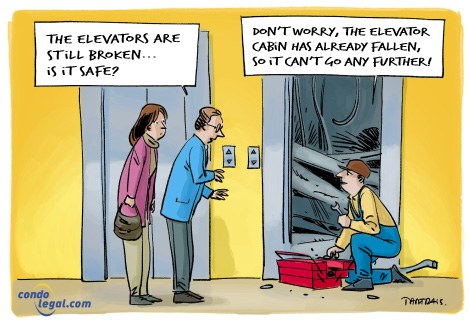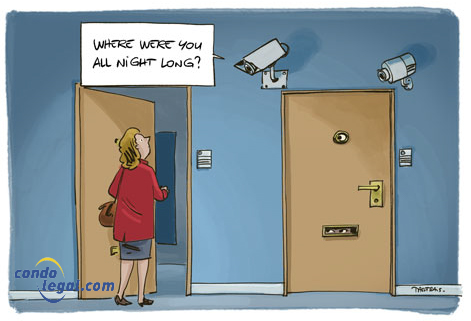Co-ownership elevators
 Many co-ownerships (condominiums) have elevators because they are built vertically; occupants who live there especially the elderly or those have reduced mobility expect them to be in continuous operation. The concerned syndicates of co-owners are thus required to guarantee that the elevators are brought up to meet the required standards. Elevators must be kept in good working order, safety work must be carried out and the technical inspection of the elevator must be carried out according to the requirements of the Safety Code; ff they are out of order, it could be the cause of serious and irreparable prejudice to the occupants and the syndicate’s civil liability could be engaged.
Many co-ownerships (condominiums) have elevators because they are built vertically; occupants who live there especially the elderly or those have reduced mobility expect them to be in continuous operation. The concerned syndicates of co-owners are thus required to guarantee that the elevators are brought up to meet the required standards. Elevators must be kept in good working order, safety work must be carried out and the technical inspection of the elevator must be carried out according to the requirements of the Safety Code; ff they are out of order, it could be the cause of serious and irreparable prejudice to the occupants and the syndicate’s civil liability could be engaged.
Legal obligations
It should be noted that under section 1039 of the Civil Code of Québec, the purpose of a syndicate of co-owners is to preserve the immovable, and to maintain and administer the common portions. In addition, section 1077 Code civil of Québec stipulates that "The syndicate is liable for damage caused to the co-owners or third party people by faulty design, construction defects or lack of maintenance of the common portions, without prejudice to any recursory action’’.
Juridical status of elevators
In divided co-ownership, according to section 1044 of the Civil Code of Québec, elevators are presumed to be common portions; consequently, declarations of co-ownership generally qualify these equipments as such.
Building Act
In addition, elevators are subject to the Building Act; this legislation allows the Quebec building Board (Régie du bâtiment du Québec) (RBQ) to ensure the quality of the construction work of a building and its equipment including elevators and other lifts (Construction Code) as well as to ensure the safety of the public accessing a building or equipment (Safety Code).
Under the Building Act which applies to all types of immovables including those held in divided co-ownership, the owner of a building, elevator or other lifts must comply with the Safety Code which contains various chapters related to plumbing, electricity, building and elevators as well as other elevating devices.
Requirements related to construction work
Chapter IV (Elevators and other lifts) of the Construction Code sets out the requirements for the construction work of elevators and other lifts installed within a building or designated as equipment for public use.
Requirements related to maintenance
Chapter IV (Elevators and other lifts) of the Safety Code groups together the requirements for the maintenance of elevators and other lifts; these requirements cover the use, operation, maintenance, verification and testing of elevators and other lifts. In this regard, the main control measures implemented by the Quebec building Board (Régie du bâtiment du Québec) (RBQ) include:
- the implementation of a structured method for assessing the safety level of elevator designs and products (Safety Code standards);
- the obligation to carry out verifications and tests at pre-established intervals;
- the obligation to immediately repair defects;
- the obligation to use qualified and certified maintenance personnel;
- maintaining a logbook, in the machine room, containing information on all maintenance activities and an up-to-date wiring diagram of the electrical protection devices.
Annual fee payable to the Régie du bâtiment du Québec
Since 1999, the owner of an elevator or other lift must pay an annual fee to the Quebec building Board (Régie du bâtiment du Québec) (RBQ) for the services it provides them. The fee includes an annual fee for elevators and other lifts, inspection fees for the same devices as well as those for sending any remedial notices.
 WHAT YOU SHOULD KNOW! Every syndicate of co-owners must allow the Quebec building Board (Régie du bâtiment du Québec) (RBQ) to affix an identification plate to its elevators.
WHAT YOU SHOULD KNOW! Every syndicate of co-owners must allow the Quebec building Board (Régie du bâtiment du Québec) (RBQ) to affix an identification plate to its elevators.
 WHAT TO KEEP IN MIND: Elevators are subject to Chapter IV of the Construction Code as well as Chapter IV of the Safety Code; the first one establishes standards for the construction of a building while the second one ensures the safety of anyone accessing it.
WHAT TO KEEP IN MIND: Elevators are subject to Chapter IV of the Construction Code as well as Chapter IV of the Safety Code; the first one establishes standards for the construction of a building while the second one ensures the safety of anyone accessing it.
 WARNING! Having come into effect on March 18, 2013, the objective of the Building Chapter from the Safety Code is the safety of occupants and people travelling in the vicinity of a building; it applies, inter alia, to any building containing apartments held in divided co-ownership having more than two floors in height and more than eight units.
WARNING! Having come into effect on March 18, 2013, the objective of the Building Chapter from the Safety Code is the safety of occupants and people travelling in the vicinity of a building; it applies, inter alia, to any building containing apartments held in divided co-ownership having more than two floors in height and more than eight units.
Back to the factsheets





